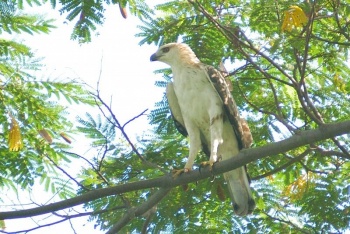Alternative name: Crested Hawk-Eagle
- Nisaetus cirrhatus
Spizaetus cirrhatus
Identification
51–82 cm (20-32¼ in)
- Brown upperparts
- White underparts
- Barred underside of flight feathers and tail
- Black streaks on throat
- Dark brown streaks on breast
Sexes alike; females larger
The name is due to the dual morph phases - a dark morph and a pale morph.
Distribution
Southern Asia: occurs in India, Sri Lanka and the Andamans and Nepal east to Vietnam and south to the Malay Peninsula. Also occurs in the southern Philippines, Borneo, Sumatra and Java.
Taxonomy
New studies place this species in the genus Nisaetus instead of Spizaetus.
Flores Hawk-Eagle was recently split from this species[1], [2].
Subspecies
Five subspecies are recognised which are sometimes split in two species [1]:
Crested Hawk-Eagle (Nisaetus cirrhatus):
Changeable Hawk-Eagle (Nisaetus limnaeetus)
- limnaeetus from north-east India to the Philippines, Borneo, and Java
- andamanensis in the Andaman Islands
- vanheurni on Simalur
Habitat
Deciduous and evergreen forests, gallery forests, open woodland and savanna from sea-level up to 3,300m, hunting over forest edge and clearings.
Behaviour
Breeding
The stick nest isplaced in a tree. A single greyish-white egg is laid.
Diet
The diet includes mammals which include squirrels, hares and rats, small and large birds and reptiles such as lizards, frogs and snakes.
Movements
Generally considered a resident species.
Vocalisation
Call: loud, high-pitched ki-ki-ki-ki-ki-ki-ki-ki-kee.
References
- Clements, J. F., T. S. Schulenberg, M. J. Iliff, S. M. Billerman, T. A. Fredericks, B. L. Sullivan, and C. L. Wood. 2019. The eBird/Clements Checklist of Birds of the World: v2019. Downloaded from http://www.birds.cornell.edu/clementschecklist/download/
- Avibase
- Handbook of the Birds of the World Alive (retrieved November 2015)
- Wikipedia
Recommended Citation
- BirdForum Opus contributors. (2025) Changeable Hawk-Eagle. In: BirdForum, the forum for wild birds and birding. Retrieved 30 April 2025 from https://www.birdforum.net/opus/Changeable_Hawk-Eagle
External Links
GSearch checked for 2020 platform.1







